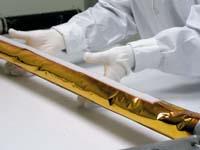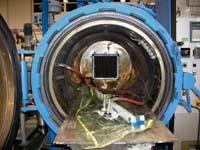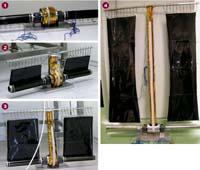Ultra-fast spatial structures

These structures are manufactured from a carbon fiber fabric and thermoplastic polymers, that is, softening polymers and adaptable to heating, which when cooled are governed and maintained the given shape. Thermoplastic polymers can be heated, molded and cooled as often as desired without deteriorating, which is necessary for the study of space materials, as it is essential to perform repeated tests.
Two types of fabrics, five polymers
In a project carried out at the Inasmet-Tecnalia research center, with the support of ESA and the participation of other institutions, two types of fabrics and five polymers have been tested. As for the fabrics, they have worked with two carbon fibers of different mechanical characteristics and grammages. As for polymers, three commercial polymers have been analysed --polyamide, high-density polyethylene and polypropylene - and two other custom-made polymers --polymethacrylate and polypropylene. The first three were purchased in film form and the last two were synthesized in it from custom-formulated monomers.
In order to carry out the tests, the fabric is combined with the polymer in various forms and the samples are inserted into the autoclave at high pressure and temperature, in vacuum, to obtain a suitable impregnation.
It has been studied whether Inasmet samples are properly softened and hardened when heated and cooled. Mechanical, physical, folding, aging, etc. tests have been performed. All possible combinations of tissue/polymer have been analyzed and, in view of the results, a fabric and a polymer have been selected, one of carbon fiber of the highest characteristics and grammage, and a polypropylene polymer. It is precisely they who behave best in spatial conditions.

Solar panels
Once the right material was selected, it had to be tested. A solar generator has been designed for this purpose. The prototype consists of several fixed parts: immersive experimental solar panels and a kind of arm and mast that supports the structure.
This mast is formed by thermoplastic polymers. It has several layers. The base has a carbon fiber fabric impregnated with polymers. Around there is a heating fabric to heat and soften the polymer when necessary. Heat up to 70ºC. Inside the pipe there is a plastic distributor that prevents when bending the pipe the base tissue is glued. Finally, there are layers of environmental protection on the outside.
The entire structure is kept folded and would be sent to space. For the expansion of the prototype electric current is supplied to the heating fabric that softens the polymer. Air is then pumped into the tube in about 0.3 bars. The air inflates the structure like a balloon. Once inflated, the electrical current is interrupted and the structure cooled. And when cooled, the polymer hardens and the structure becomes rigid. Then the wind is stopped pumping.
They have shown that in space, without gravity or atmosphere, it is easier than on Earth, in a special chamber that simulates these conditions.

According to Nerea Markaide, responsible for the project, "it seems somewhat light and weak, but it must be taken into account that in space there is no gravity, there is no weight of the air we have on Earth." Therefore, after several calculations and trials, they have seen that "weakness" is sufficient.
The aim of Inasmet-Tecnalia has been to find the right material within a broader project of the European Space Agency. Currently, the use of the material is the responsibility of ESA.
Buletina
Bidali zure helbide elektronikoa eta jaso asteroko buletina zure sarrera-ontzian











